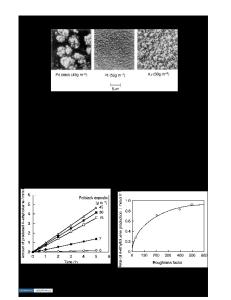Fabrication of Ionic Polymer Metal Composite Actuator with palladium electrodes and Evaluation of its Bending Response
- PDF / 441,794 Bytes
- 6 Pages / 612 x 792 pts (letter) Page_size
- 42 Downloads / 316 Views
1190-NN11-29
Fabrication of Ionic Polymer Metal Composite Actuator with palladium electrodes and Evaluation of its Bending Response Takuma Kobayashi, Takeshi Kuribayashi and Masaki Omiya Department of Mechanical Engineering, Keio University, 3-14-1, Hiyoshi, Kohoku-ku, Yokohama, Kanagawa, 223-8522, Japan
ABSTRACT We built up the way of fabricating ionic polymer metal composite (IPMC) actuator with palladium electrodes and evaluated the bending response under various solvents. We fabricated IPMC consisting of a thin Nafion® membrane, which is the film with fluorocarbon back-bones and mobile cations, sandwiched between two thin palladium plates. The surface resistivity was 2.88±0.18Ω/sq. , so it could be said to have enough conductive property. Then, we observed its cross section by using FE-SEM. As a result, palladium plates were evenly coated and its thickness was about 30µm. Then, we evaluated the bending response under the various solvents. In the evaluation, we study the influence to bending response by cation forms and mol concentration. We used Li+, Na+ and NH4+ as cation form and all of them were 1.0mol/l. In terms of ionic radius, Li+< Na+< NH4+. As mol concentration, we use 0.1mol/l, 0.5mol/l, 1.0 mol/l and all of them were Na+ form. As a result the bigger the ionic radius become, the larger bending response IPMC actuator showed, and the higher the ionic concentration become, the larger bending response IPMC actuator showed. Then, we conducted the modeling of IPMC actuator.
INTRODUCTION An ionic polymer-metal composite (IPMC) consisting of a thin perfuorinated ionomer membrane, electrodes plated on both faces, undergoes large bending motion when a small electric field is applied across its thickness in a hydrated state[1]. The characteristics of IPMC are ease of miniaturization, low density, and mechanical flexibility. Therefore, it is considered to have a wide range of applications from MEMS sensor to artificial muscle. However, there are problems on IPMC. First, it is high-priced because most of IPMC actuators use gold or platinum as electrodes [2, 3]. Second, its mechanical and electric characteristics under various solvents have not been clarified because of the complex mechanism of the deformation [4, 5]. In order for IPMC actuator to be widely put to practical use, we should solve these problems. Hence, this research focuses on fabrication of IPMC actuator with palladium electrode, which is cheaper than gold or platinum, and evaluation of its bending response under various solvents.
EXPERIMENTAL DETAILS Fabrication of IPMC actuator with palladium electrodes We used Nafion®117 ,whose thickness is 183µm, as thin perfuorinated ionomer membrane. Nafion® is chemically and thermally stable and excels in the electrochemical property[6]. It has been often used in the IPMC study. As electrodes, we chose palladium. Palladium is inferior in corrosion resistance and electric conductivity to gold and platinum, but it is quarter as expensive as they are, and one third as weighty as they are, so when we use pall
Data Loading...










